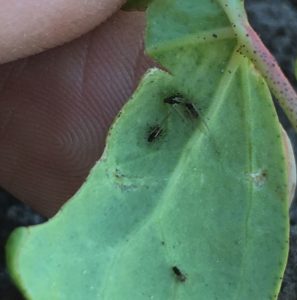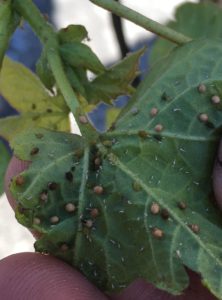Cotton field maturity ranges from emergence to plants with 3-4 true leaves. Most fields are cotyledon to 1-true leaf. The normal insect pests we see in seedling cotton include thrips, cutworms, mites and aphids.
When scouting seedling cotton plants, I usually pull a plant from the ground and look at the leaves for insects. This week I have found Cotton Aphids in many fields. Most of the aphids are winged, indicating they have recently arrived. But some plants have both winged and small wingless aphids.
First, aphids are rarely yield limiting to seedling cotton plants. Most cotton fields are planted with seed treated with insecticides which will control cotton aphids after they feed on the plants for a few days. These aphids are an important food source for natural enemies such as lady beetles and parasitoids. Thus, insecticide treatments for aphids in pre-blooming cotton should be avoided if possible.
Second, the number of aphids necessary to justify an insecticide on seedling cotton is more than 50 aphids per leaf. This population is rarely found.
In fields with cotton aphids, I suggest giving the environment and beneficial insects and fungi the opportunity to control the aphids without the need for an insecticide application. Natural control of cotton aphids is common on the Texas coast and costs nothing.
One of the beneficial insects I found today is the aphid parasitoid Lysephilbus testaceipes. These were found on older volunteer plants with 4-5 true leaves.
Parasitized aphids are called aphid mummies. They are larger, tan colored aphids with a developing parasitic wasp inside. These aphids are no longer feeding on the plant. If 10-20% of the aphids are mummified, most of the others are probably also parasitized as well.
Lady beetle adults and nymphs, green lacewings nymphs and syrphid fly larvae can also prey on aphids.

Aphids killed by the fungus, Neozygites fresenii, appear as masses of gray colored fuzz. (http://cottonbugs.tamu.edu/foliage-feeding-pests/aphids/)
Rain and heavy dew will encourage the development of aphid feeding fungi. look for aphids having a fuzzy appearance, the fungus Neozygites is the likely culprit. This fungus can decimate an aphid population.
If you find a field that exceeds this threshold (50 aphids per leaf), wait 2-3 days and return to see if the aphids are still above this level or if their numbers are declining.
More information on aphids in cotton can be found HERE.

